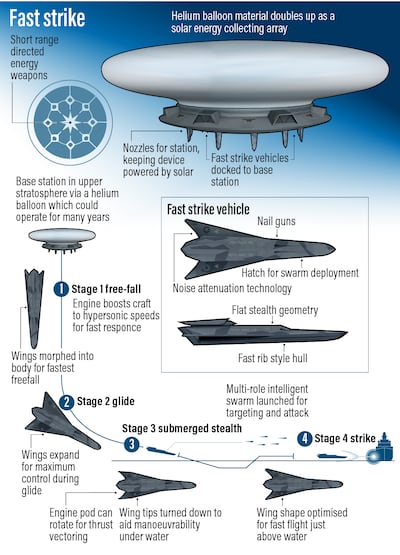Warships that plummet from the stratosphere into the sea and submarines made from coral have been proposed as futuristic vessels for the Royal Navy.
In a bid to shape Britain's Navy into an ultra-modern force, engineers have been given the freedom to come up with plans using renewable energy and drone technology.
Among the proposals is a giant helium-filled vessel that lingers 30 miles above Earth, able to launch fast strike vehicles that free fall into the sea before coming up to the surface to attack ships.
While some of the ideas put forward appear highly futuristic, others may help the British fleet modernise at a time when the US, Chinese and Russians are all examining innovative battle-winning designs.
“In a future scenario if we find ourselves unable to compete traditionally in terms of mass, we must think differently if we are to regain operational advantage,” said Second Sea Lord, Vice Admiral Nick Hine. “The young engineers who worked on this project are thinking radically and with real imagination and that reflects how the Royal Navy is thinking too.”

With a £24 billion ($33bn) increase in spending over the next four years, the Navy is looking to invest in innovative, semi-autonomous warships that will still provide “lethality”, according to its recent Defence Command Paper.
Young designers from the Naval Engineering Science and Technology (UKNEST), have put forward their ideas for the Future Autonomous Fleet programme that could shape how it operates over the next 50 years.
Experts believe that with both the Americans and Chinese currently using stratospheric balloons for surveillance it is not unrealistic to see them mounted with weapons.
The Navy’s proposed airborne ship carrier, powered by solar energy, would contain dozens of fast-strike vessels that would drop then glide to earth, submerge and surface to skim across the waves to launch missiles at ships. The helium balloon would operate for several years in the stratosphere and its height would allow it to deploy stealthy attack ships rapidly to trouble spots around the world.

A sea-based aircraft carrier proposal would carry drone submarines and fly unmanned aircraft. As well as launching satellites manufactured by utilising 3D printers on board, it would have laser guns, ultra-fast rocket propulsion and potentially be semi-submersible. It would also be powered by helix-shaped wind turbines and for alternative energy use gill fins to extract hydrogen from the sea.
Among the more curious designs is a proposal to build a sparsely manned submarine with the outer skin made from very tough brain coral.
The boat could manufacture and launch hexagonal block drones able to “shape shift” to deceive radars, transport equipment, or create blocks for enemy swarm drones. They could also hitch rides by attaching themselves to the hulls of regular warships for recharging or relocation. The coral-made mother ship would also repair and stow the hex blocks.

A final proposal is for an autonomous combat vessel that could operate both above and below the waves. The “Trimaran” would carry its own small drone ships under its wing or in the main hull, launching them when close to the enemy.
The Navy will implement one of its futuristic designs this decade — the Persistent Operational Deployment Systems (PODS).
Shaped like a shipping container, PODS will be delivered to warships at sea via heavy-lift drones or autonomous boats delivering unmanned vessels for reconnaissance or quadcopters, to deliver supplies or disaster relief stores ashore.










